Real virtuality yesterday, today and tomorrow

A few years ago, with sweet anticipation and sinking, we read the next batch of news about Oculus Rift. But at some point other developments in the field of virtual reality (BP) suddenly began to appear, depriving Rift of a peculiar monopoly on novelty. With the advent of cardboards, the threshold for entry into BP fell below the baseboard. The technology has become even closer, more accessible, although the industry is still adjusting to the new product. There is an obvious lack of ideas, and virtual reality specialists are rare birds. In the meantime, innovators are looking for interesting ways to develop technology, let's remember how its development began. And at the same time we will think about how BP can transform in the future.
Visualization
The story of BP began long before John Carmack , who was at the forefront of the 3D shooter genre, had a hand in creating the Oculus Rift. Why, even a few years before Carmack was born, in 1962, Morton Heilig received a installation patent that can be considered the progenitor of virtual reality technology - Sensorama .

')
Sitting in a chair and plunging his head into a futuristic bell, the user could, for 25 cents (a considerable amount at the time), look at a choice of one of five short films that lasted two minutes. Sensorama offered to the unbalanced viewer of the middle of the last century such heights of technologies as color stereo image , stereo sound, smells, wind (from the built-in hairdryer) and a vibrating chair.
In 1965, Ivan Sutherland presented his development - a device that is considered to be the first virtual reality helmet in history. The image was generated using a computer, although the term "computer graphics" is hardly applicable here. First, the video signal was output to two CRT monitors, and then the image from them was transmitted to the eyepieces through the optical system. In fact, it is difficult to call it a helmet - the device was a three-dimensional stationary system suspended from the ceiling. But here there were the beginnings of interactivity: the image changed depending on the movements of the user's head.
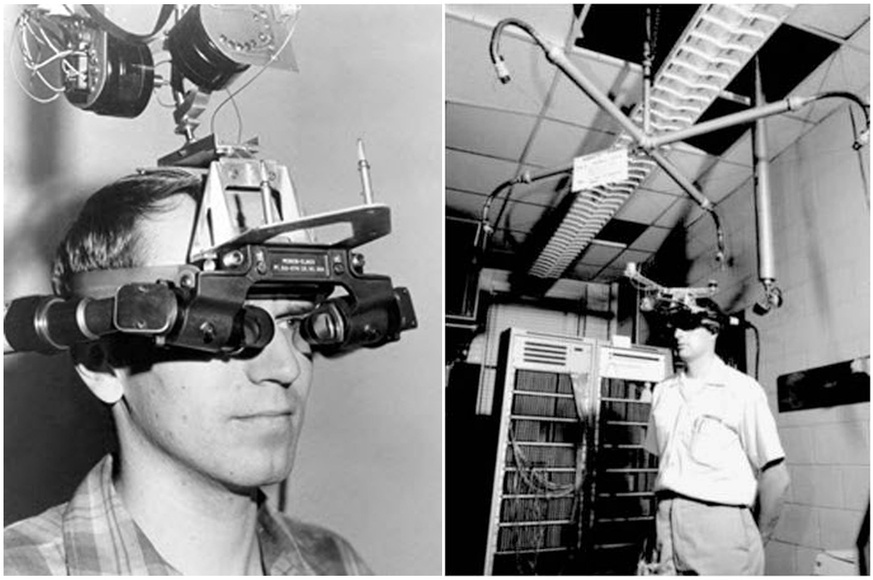
In the first half of the 1960s, the development of algorithmic tools for creating virtual worlds began. Lawrence Roberts ( Lawrence Roberts ), who studied with Sutherland at the Massachusetts Institute of Technology, created an algorithm for removing hidden or blocked surfaces when calculating images with a computer, which saved more than a modest computing power of the time. And in 1965, Roberts presented a homogeneous coordinate scheme for calculating transformations and perspectives that formed the basis for new algorithms for calculating hidden surfaces.
In subsequent years, development in the field of BP basically did not go beyond the walls of universities and military laboratories. In particular, the US Air Force sponsored the development of a helmet for fighter pilots designed to simplify aircraft control and interaction with its systems, streamline the flow of all kinds of incoming information in combat conditions. To display the virtual cockpit a very wide field of view was chosen - 120 degrees.

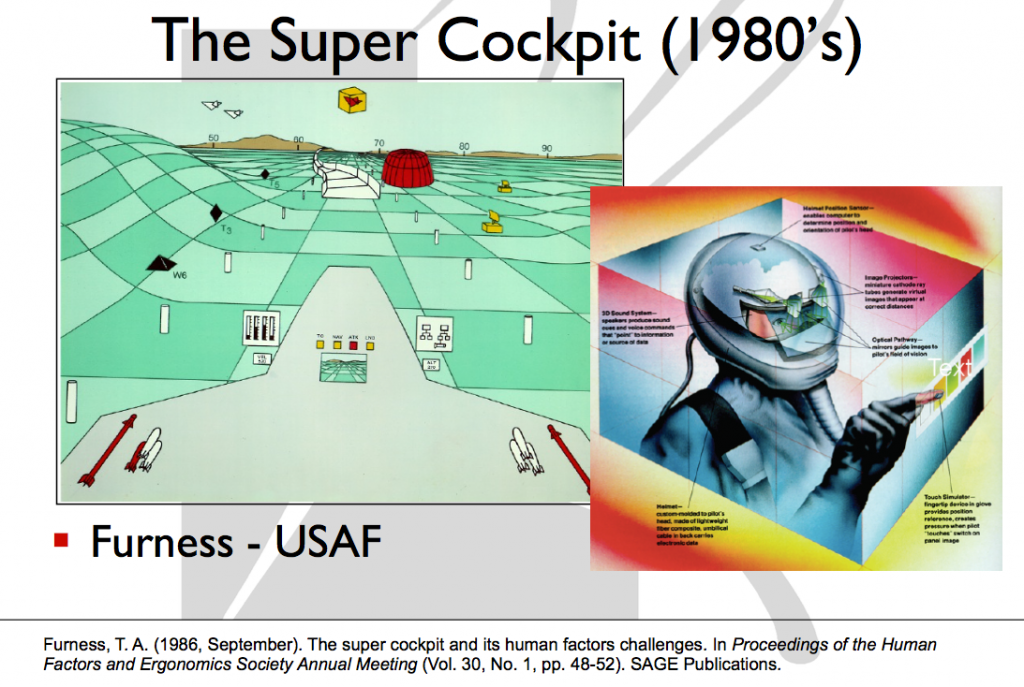
Back in the Soviet Union, a helmet-based target designation system was introduced for the first time, allowing pilots to control the guidance of weapons only with a single turn of the head. And today, developments in this area are actively continuing, so it is likely that in the future, military pilots will receive “transparent” cockpits when a digital image of the entire space surrounding the aircraft is transmitted to the helmet.
The next important milestone in the history of the development of virtual reality was the project " Aspen Motion Picture Card ", implemented in 1978. With the help of a special installation on the roof of the car, the streets of the town of Aspen were filmed on 16-mm film. These images were later translated into textures, stretched three-dimensional models of buildings.
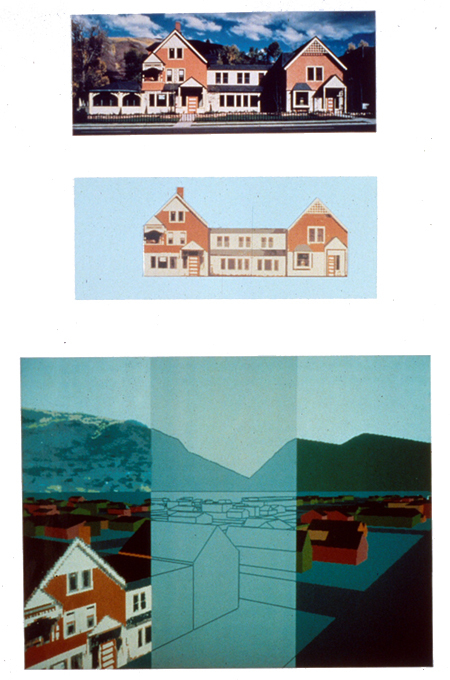
Then a lot of short videos of “driving around the city” were generated, one fragment per one quarter. The clips were recorded on the LaserDisc optical media, from where they were read, depending on the direction of movement, which the user selected using the menu displayed on top of the image. Two virtual versions of the city were made - summer and winter.
In 1985, a relatively cheap virtual reality station was developed for NASA. It was a VIVED (Virtual Visual Environment Display) helmet system and PDP-11/40 computer from Digital Equipment Corporation. The station was equipped with two 19-inch monitors, cameras, sensors for the movement of the head and a specially designed video signal processing circuit. The station was used for such tasks as the study of the surface of other planets, hydrodynamic modeling, control of space robots.
Reach for the stars
As you know, for immersion in virtual reality is very important to provide the user the opportunity to interact with objects. A modern, cheap solution - unpretentious manipulators with a pair of buttons.
But the ideal option is a complete simulation of the hands. The first virtual glove that allowed us to track and transmit the movements of our limbs, the Sayre Glove, was developed in 1977 by Tom Defanty and Daniel Sandin. The degree of flexion of the fingers was calculated in a curious way: tubes passed along the fingers, at one end of which were sources of light, and at the other - photoreceivers. The more the tube was bent, the less light came to the sensor, so that the flexing of the fingers could be calculated.
In 1983, Gary Grimes patented Digital Data Entry Glove gloves, equipped with a brush positioning sensor in space. Instead of tubes, fiber is used here.
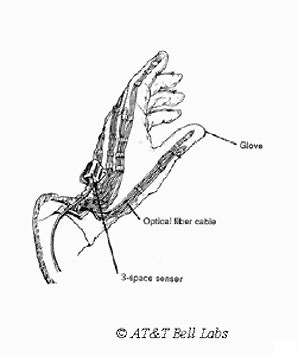
Soon the first commercial DataGlove gloves appeared, costing $ 9,000.
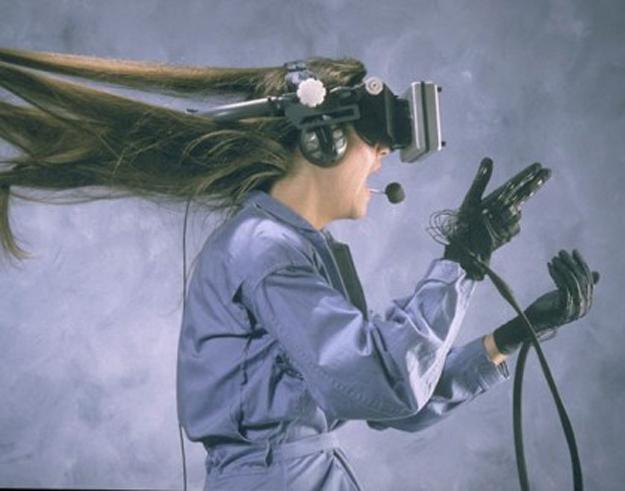
Shake my hand
Another component of virtual reality technology has become the transfer of tactile sensations. In 1967, Frederick Brooks (Frederick Brooks) launched the GROPE project , whose goal was to create a tactile interface designed for molecular engineering. That is, the person had to literally feel the possibility of combining certain molecular structures. As a result of the research, the GROPE-I installation, which worked in two dimensions, was born.
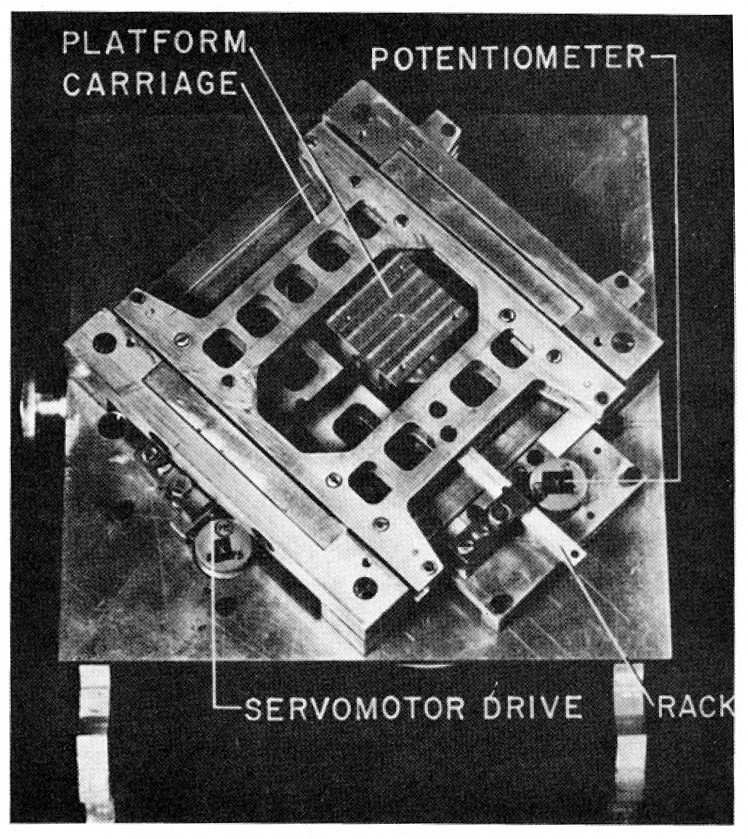
In 1976, GROPE-II was created, which could work in all six dimensions (three - movement in space and three - rotation). True, the installation was somewhat ahead of its time: computers could only process very simple models in real time.
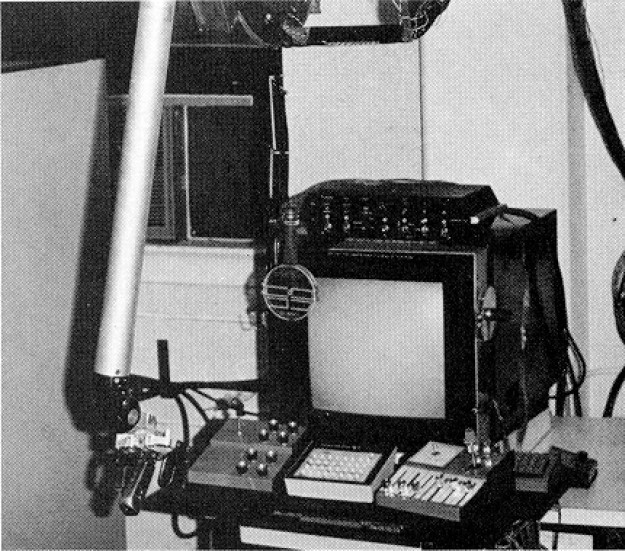
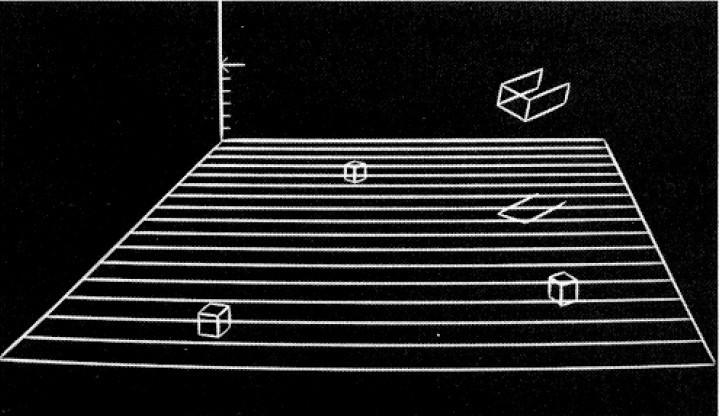
According to the calculations of the Brooks team, for realistic modeling of the forces of intermolecular interaction, it was necessary to increase the computational power by 100 times compared with the available at that time. As a result, the project was frozen for a decade. In 1986, computers achieved the desired performance, and in 1988 the GROPE-III unit was created.
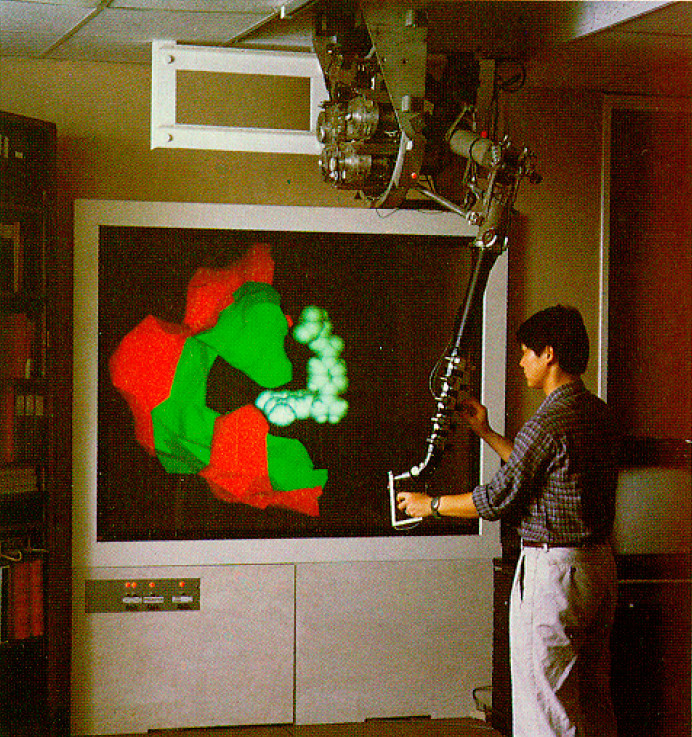
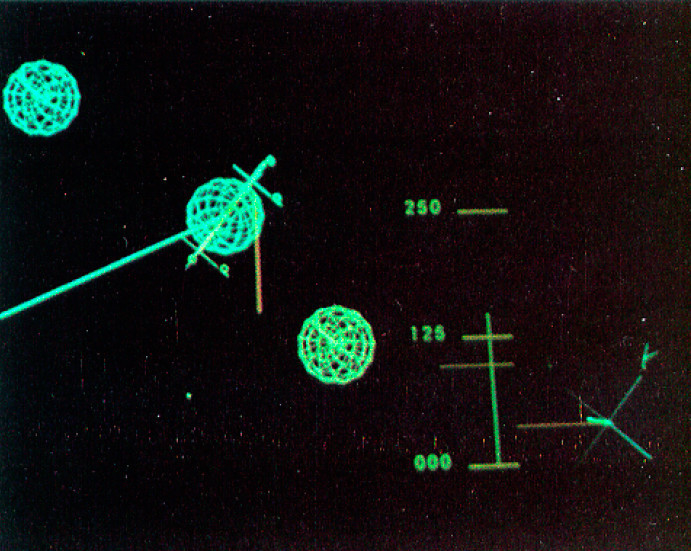
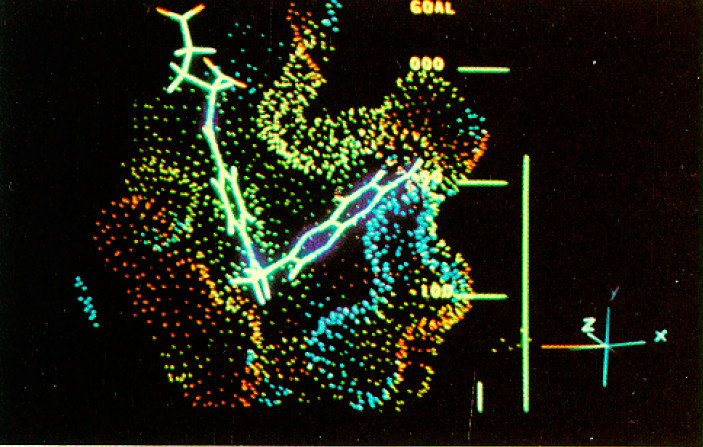
Today, in games and other virtual entertainment, feedback is almost not used because it complicates and increases the cost of equipment, and the load on computing power increases. But there are areas where tactile interfaces are of paramount importance, for example, in surgical robotic installations.
Previous generation of virtual reality
Due to the numerous difficulties and imperfections of technology, the development of BP systems in the 1970s – 1980s was not shaky. However, by the early 1990s, the development of microelectronics and the growth of computing power made it possible again to recall such a promising idea. In 1991, Sega loudly advertised the Sega VR helmet, announcing that it would be released soon. Alas, they failed to bring the product to the level of commercial attractiveness, and in 1994 the project was closed.
You can also mention slot machines Virtuality , equipped with helmets with a delay of no more than 50 milliseconds, joysticks, microphones and the ability to play on the network here, in the general nesting area. Each helmet had two LCDs with a resolution of 276 × 372 pixels.
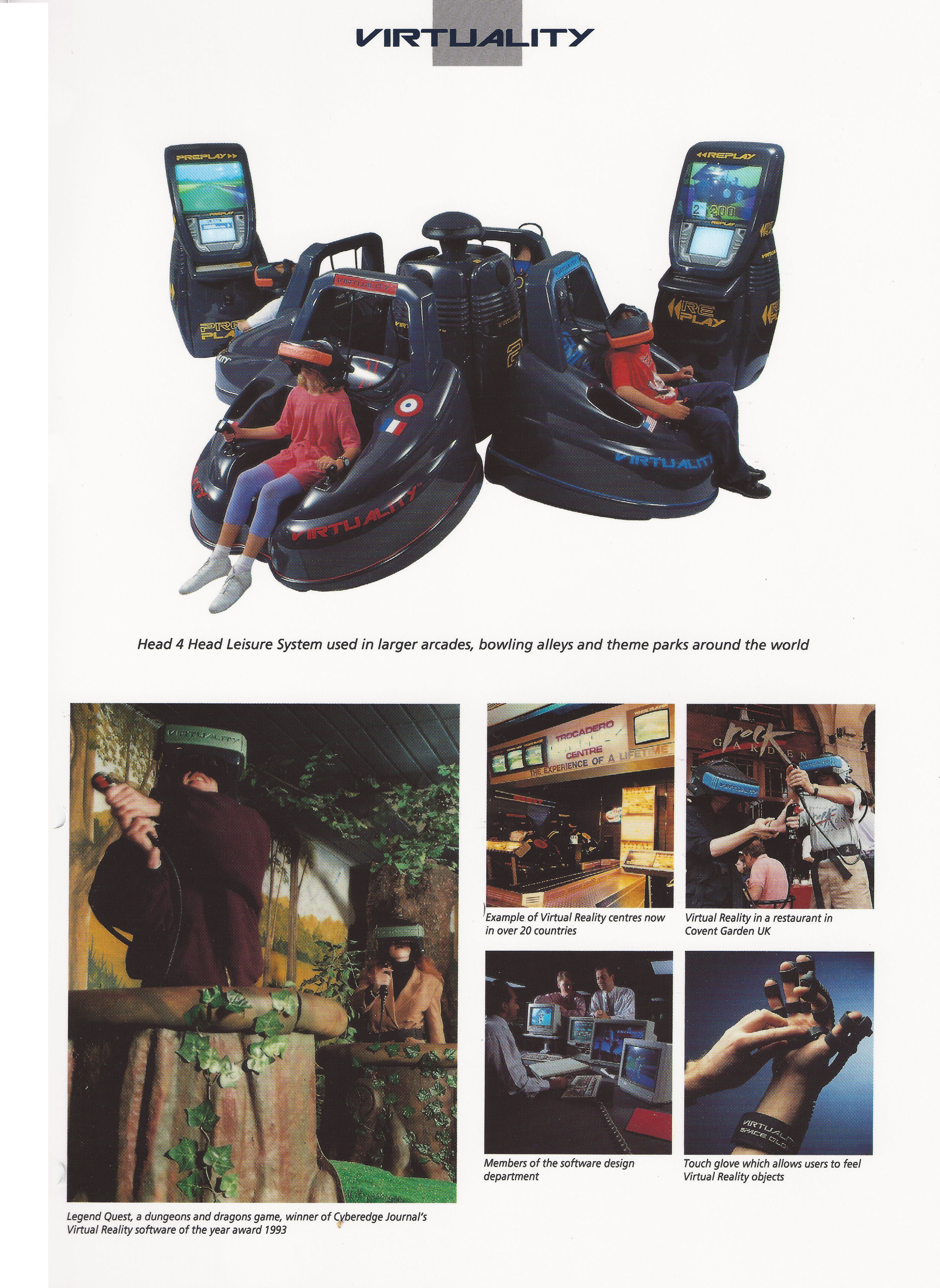
To show convincing three-dimensional worlds, allowing the user to interact with them, is a great achievement. But still helmets and cardboards are not suitable for everyone. They quickly tired eyes, and long-term use can badly affect vision. In addition, errors in the sensors and a lack of computing power can lead to out of sync between body movement and the image, which can cause unpleasant physical sensations and even destroy the effect of immersion. Therefore, technologies in which a person is freed from the helmet and other devices, and the image is projected onto the walls, floor, ceiling and other surfaces within a particular room, have become one of the branches on the Tree of Virtual Reality. In other words, it is a kind of augmented reality .
One of the first developments in this area was the CAVE project. The first prototype, which appeared in 1992, was a cubic space with an edge length of 3 meters. All internal surfaces served as reflective screens on which the stereo image from the projector was projected.
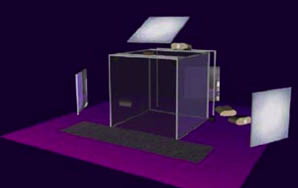

Here, the user has not yet been completely free from wires and gadgets. At a minimum, you had to wear stereo glasses to feel the effect of the volume of the projected image.
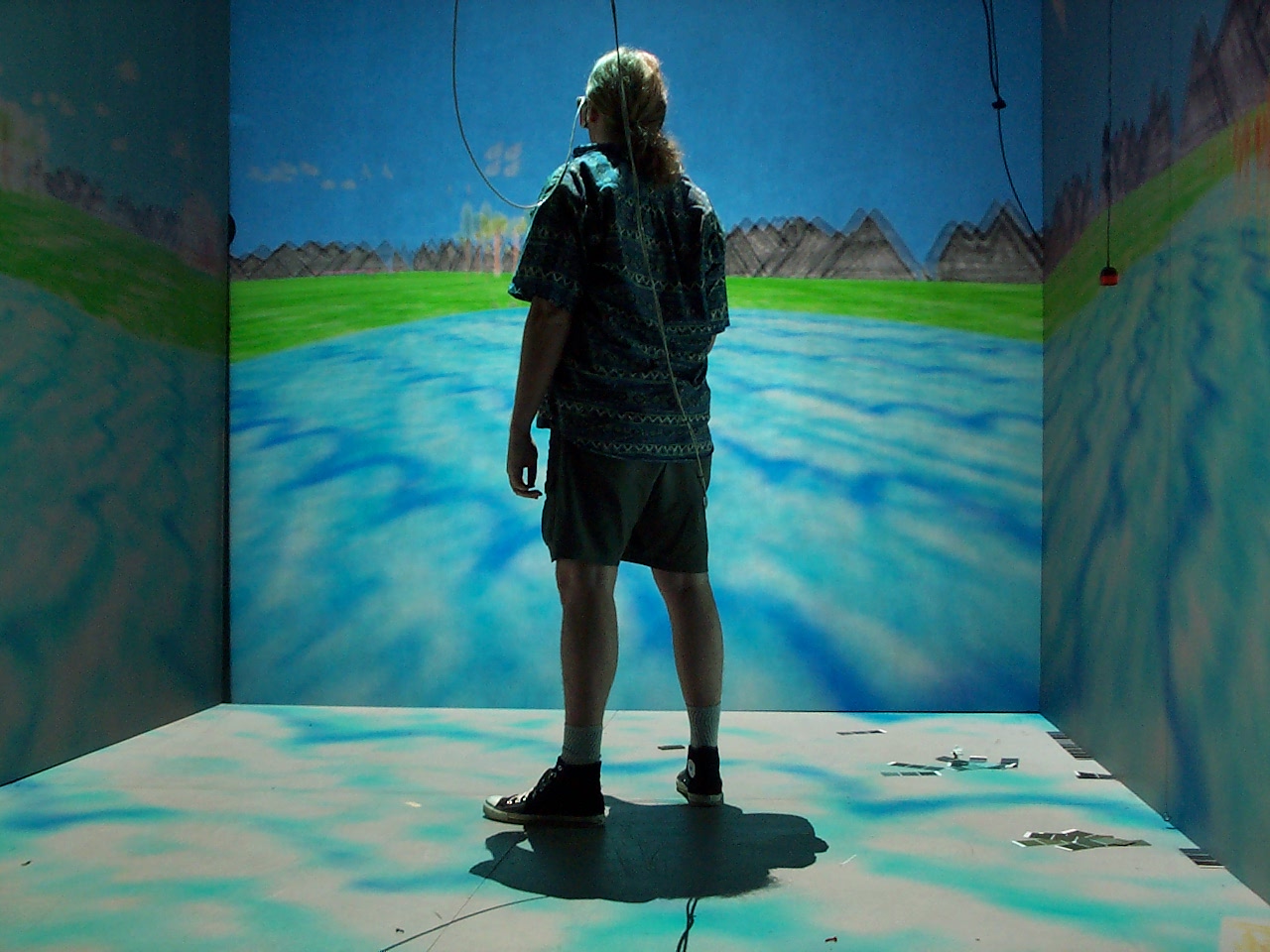
The system monitors the position of the user's head and hands, adjusting the stereoscopic effect. A person could walk around the cube, “exploring” the virtual world, and interact with objects using a three-button manipulator.
The “room” concept formed the basis of a later project - Microsoft RoomAlive.
The disadvantages of this approach are obvious: cumbersome, not too high quality of the resulting image, dependence on lighting, the complete lack of mobility. But when traveling in space, a person feels unlike himself more confidently, without fear of stumbling upon furniture or walls, as is the case with helmet users.
In late 1994, the company Victormaxx released its CyberMaxx helmet. The resolution of each screen was 505 × 230, it was possible to adjust the color tone of the image. The helmet cost was quite expensive and was very picky about computer performance.

In 1995, Nintendo swung at the helmet and its very specific product , which had a monochrome image, turned out to be absolutely a failure.
Also in 1995, Virtual IO released its version of the helmet, i-glasses. It was a rather interesting product: compact, lightweight, comfortable to carry. Unfortunately, the mobility of this helmet was conditional: a bunch of cables, a power supply, its own system unit, not counting the device itself ... Image resolution reached as much as 640 × 480.
It is also worth mentioning the helmet Forte VFX1 , whose design even today can be called very modern. Conciseness of the lines, nothing superfluous. The resolution was very modest - 263 × 230 pixels. But in the kit there was a small washer-shaped joystick, which allowed to control in three-dimensional virtual space.
After a couple of years, the Glasstron helmet developed by Sony appeared on the market. Several models were released, the best of which had a resolution of 800 × 600. The helmet had the ability to switch control modes: either the player moved in the direction of his gaze, or the movement and the review became independent, so that, for example, you could turn your head in the cockpit.
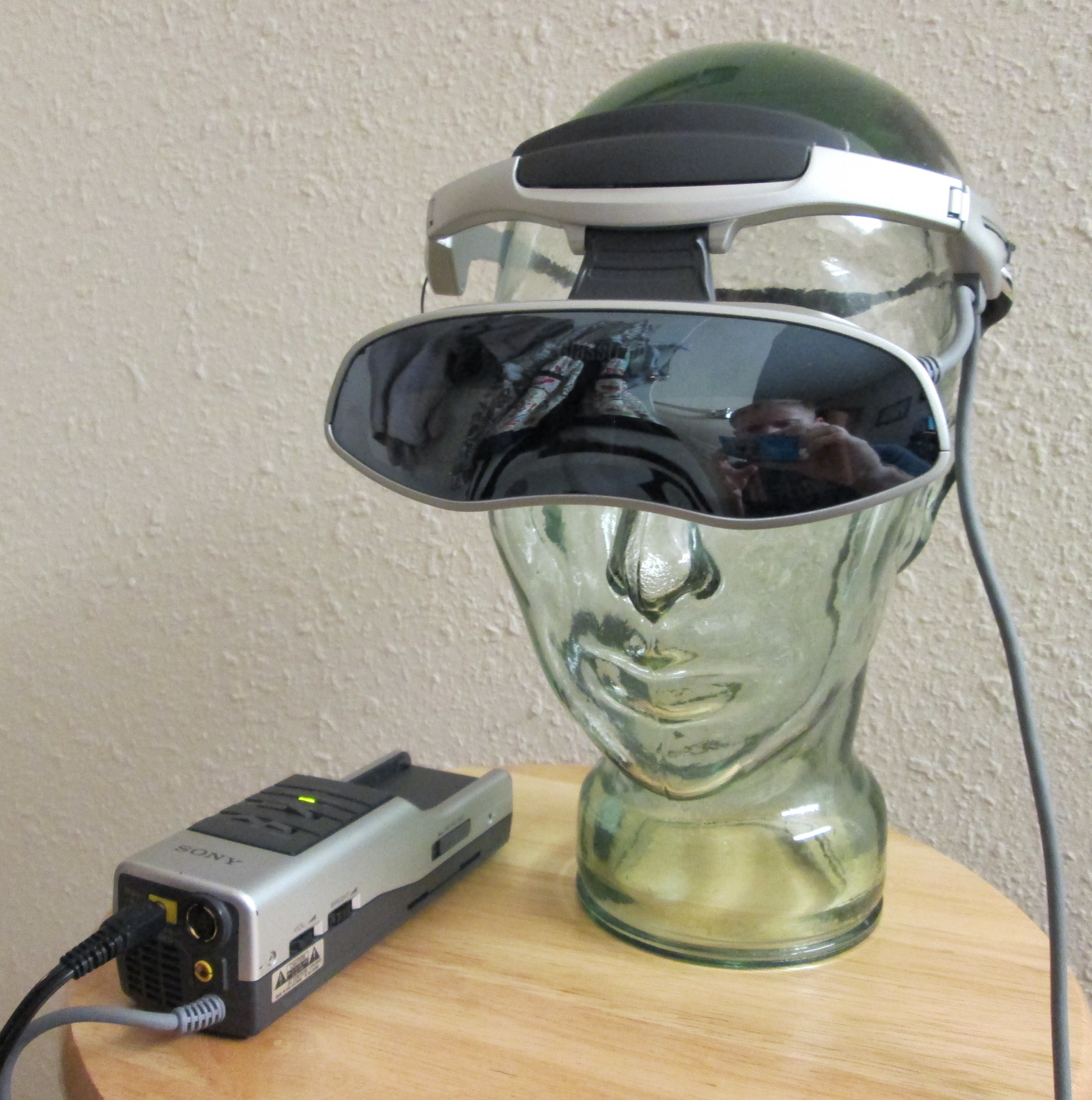
New wave
After a surge in the nineties of interest in virtual reality, there was a long lull again. And in February of 2012, the first information appeared on the new development related to the field of augmented reality, when computer graphics are superimposed on the surrounding space. This novelty was Google Glass glasses.
In the same year, another “celebrity” of the world of gadgets was announced - the Oculus Rift helmet. It is noteworthy that a considerable share of the budget was collected on Kickstarter. After about four years, in January 2016, the first batch of “rifts” was sold on pre-order.
And then, one after another, they began to announce new virtual reality devices. In the fall of 2013, it became known that Sony is working on a PlayStation VR (Project Morpheus) helmet, designed for use with game consoles from this company. The resolution is 1920 × 1080. So far, the device is in development, its launch is scheduled for 2016.
In 2014, an early prototype of the HTC Vive helmet, developed in collaboration with Valve, appeared. The resolution of both screens is 1080 × 1200. The device went on sale recently. Included are two manipulators. In addition to all sorts of sensors that are stuffed with Vive, two additional external stations are used that track the player’s position.
In 2014, the well-known Google Cardboard project was announced. The idea is simple to genius: the user himself assembles a helmet from cardboard clippings, inserts two lenses and a smartphone. Everything, welcome to virtual reality for the
The same idea - using a smartphone as a “filling” - formed the basis of the Samsung Gear VX helmet. It is designed to work with the Samsung Galaxy Note 4. Naturally, as is the case with the cardboard, the level of immersion and image quality are not at all the same as those of full-fledged helmets. But the device is much cheaper, extremely easy to use and does not require bothering with the configuration of the computer and games.
Razer also decided to grab a piece of cake at the celebration of the life of virtual reality. Together with Sensics, they are developing a project OSVR - Open Source Virtual Reality . This is another helmet, with a resolution of 1920 × 1080. Its feature is the openness of the source code of the device software and game development tools. Such a friendly device for enthusiasts of development of BP.
Google Glass today is not the only interesting project in the field of augmented reality. Work on Microsoft HoloLens is already completed. These are quite massive transparent glasses in which the holographic image of virtual objects fits into the real world. Points are equipped with four cameras that scan the surrounding space, all kinds of sensors and a powerful processor. The device does not just project objects, but also allows you to interact with them, recognizing the user's gestures. On sale it has not yet arrived, but the cost for developers is already known - $ 3,000.
What's next?
Apparently, in the next few years, the mainstream of virtual reality will be full-fledged helmets. They will be improved, increasing resolution, performance, accuracy of tracking user actions. For example, Kickstarter raised money to create a FOVE helmet, which, for greater accuracy, tracks player's eye movements. It is argued that this will help reduce fatigue and expand gaming opportunities: for example, you can choose the direction of movement by turning your head and aiming with your eyes. Another example of improving an idea is to create a helmet with a viewing angle close to the natural one, when peripheral vision is activated, as in a StarVR helmet. It plays a crucial role in shaping a sense of presence and belonging.
Also for sure there will be gadgets for those who like to play with the helmet. Fans of 3D shooters will definitely appreciate the joysticks in the form of weapons. The trick is that they will emulate the recoil when shooting (like Striker VR, for example), immersing them even more into the game atmosphere.
Most likely, we are waiting for the rapid growth of the video, shot in a format of 360 degrees. It can already be seen today on a regular computer, but in a helmet, something quite different! Facebook recently announced the creation of a video installation for shooting "spherical" video - Surround 360. It is equipped with 14 cameras, each of which shoots at a resolution of 2048 × 2048 and 60 frames per second. Yeah, you have to do more than the scenery.
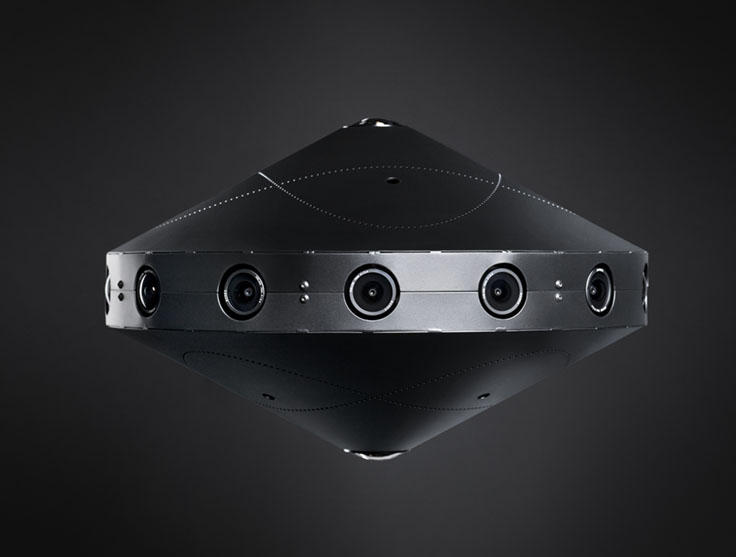
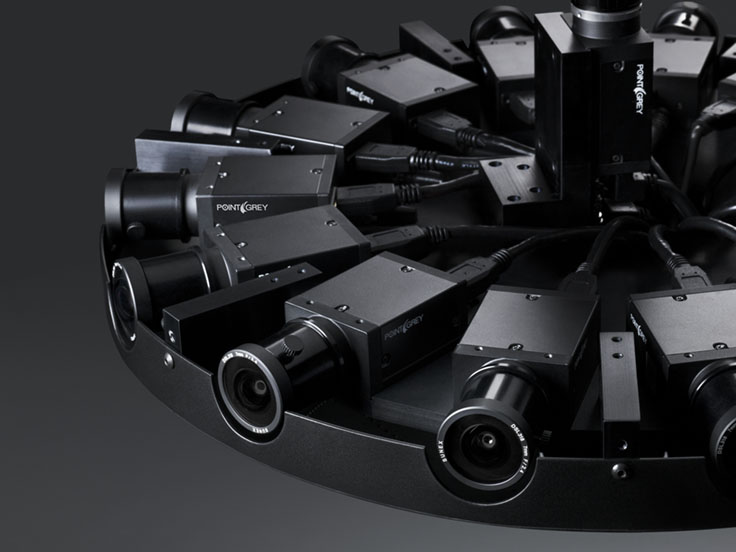
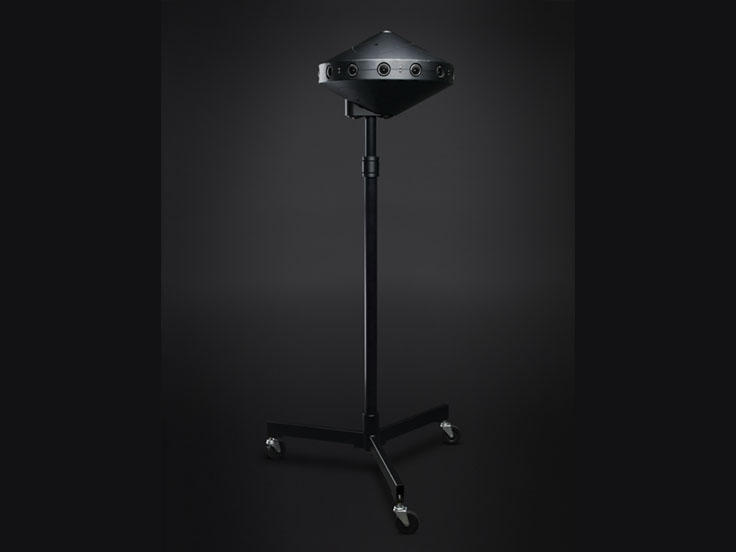
In fact, this is the answer to last year's Google project Jump .
Also one of the trends, according to Zuckerberg , may be the emergence of devices in which technologies of virtual and augmented reality will be combined. As in the helmet Sulon Q, with a display resolution of 2560 × 1440.
Although, according to the same Zuckerberg, in the future, the augmented reality will prevail, and the gadgets themselves will tend to look like glasses, not helmets. And there, you see, the reality will be supplemented and virtualized right in our head.
Wait and see. May the pixel be with you!
Source: https://habr.com/ru/post/393047/
All Articles